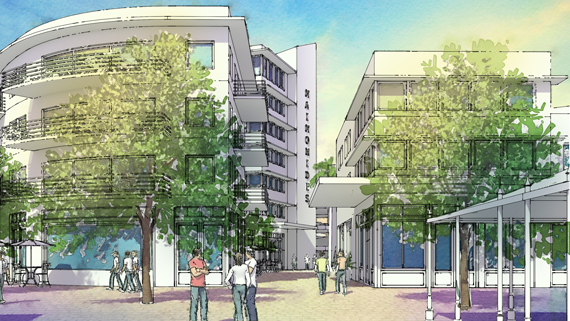It’s record-setting time on Miami Beach. Hedge fund honchos and Russian billionaires are paying an average of $3,130 per square foot for new condominiums at the Faena House on Collins Avenue in South Beach. Just four blocks down the street at the posh Residences at the Miami Beach Edition, buyers can pay an average of $3,020 per square foot for a unit in the 18-story tower.
A couple of miles away, the GLASS condo tower at 120 Ocean Drive has sold out. All of its 10 super-luxury units were gone in a flash for an average price of about $2,300 per square foot. And just to the north at the 321 Ocean project, buyers are getting a relative bargain, paying about $1,720 per square foot for oceanfront units.
But while the South Beach and Mid-Beach neighborhoods are sizzling with new condo and hotel projects seemingly going up overnight, there’s one part of the resort city that has been left out of the boom: North Beach, the faded home to scores of low-rise Miami Modern buildings, quiet gated single-family properties and the dowdy main drag of 71st Street, where you can’t find a Starbucks. North Beach, which stretches from 63rd Street to 87th Street and westward to Biscayne Bay, is a relic of a less affluent time while South Beach and Mid-Beach have exploded in recent years.

Jason-King-Jeff-Oris
Jeff Oris, Economic Development Division director in the city’s Office of Tourism, Cultural and Economic Development, said that while North Beach has largely remained “stagnant” over the past 20 to 30 years, a growing number of people are now searching for opportunities to buy and build there.
“There are real estate investors that are looking and starting to assemble land, kind of waiting to see what the city is going to do, as well as waiting for that pioneer who comes in and does the first project to show that it can be done,” he said.
Oris spoke during a week-long charrette, or design workshop, held in mid-February at the city-owned Byron Carlyle Theater on 71st Street. The event was hosted by the city and Dover Kohl & Partners, which Miami Beach hired to develop a master plan for its North Beach neighborhood.
The master plan arose out of Mayor Philip Levine’s Blue Ribbon Panel on North Beach, which was convened in 2014, but it was fast-tracked this year after plans to develop the Ocean Terrace historic district, between 73rd Street and 75th Street, were put on hold in a contentious election last November when voters rejected an increase in floor area ratio (FAR) for the area. Voter approval is required for any upzoning changes involving a FAR increase on Miami Beach, and the vote bitterly divided the residents of North Beach.
Supporters of the upzoning said the project would have revitalized what they describe as a blighted area. Richard Hull, president of the Normandy Shores Homeowners Association, said he believes the majority of North Beach residents supported the FAR increase.
“Four of the eight precincts in North Beach voted for it, and if it had just stayed with North Beach residents we probably would have passed it,” he told The Real Deal. “The ‘no‘ side really pushed the fear factor, saying our beaches were going to be taken away and shadows were going to be cast and that it was a rich person’s development.”
Kirk Paskal, who owns a fourplex along one of the several canals that cut through North Beach, has helped lead the local opposition to the FAR increase. He disputes any characterizations of his neighborhood as “blighted,” noting that crime in the area is low compared to other parts of Miami Beach, and said “the community is engaged” when it comes to keeping development at bay.
“We value that character and we value that history and we want to see that protected,” Paskal said.
And Nancy Liebman, a preservationist who helped lead the fight to save hundreds of Art Deco buildings in South Beach 30 years ago, said the “no” vote was a clear signal from the community.
“It was a loud message that people who live in the city are fed up with overdevelopment,” she told TRD. “They see it in their daily lives, they see it in the congestion that goes on, and it was a clear mandate to stop the overdevelopment and stop trying to raise the floor area ratio to make bigger and bigger buildings.”
With those divisions in mind, Oris said the city was committed to listening to the public when it comes to North Beach and the charrette was designed for that purpose. “Our best job is to get people out to say ‘what do you want your North Beach to be,’ and ultimately when we have a plan we want it to be the community’s plan,” he said.

Critic: Kirk Paskal
Jason King, a principal with Dover Kohl and project director for the North Beach master plan, said interest in the workshop was overwhelming, with more than 800 people visiting the design studio over the course of the week-long event. What emerged, he noted, was a “willingness to hear different sides and come up with compromises and consensus in the community.”
“We were worried coming in after a very controversial public referendum that this was going to be a community too polarized for us to find consensus issues to address,” King said. “That hasn’t been the case at all.”
An informal poll of residents conducted at the conclusion of the charrette found that creating a Town Center along 71st Street was a top priority. An economic analysis prepared by Miami-based Goodkin Consulting, which does market research for real estate clients around the world, said turning the main drag into a pedestrian- and bike-friendly neighborhood with retail and restaurants in mixed-use buildings would attract the two key demographic groups that could benefit the area: young millennials and baby boomers.
Jack Winston, a principal with Goodkin consulting, said the city should consider changing height restrictions along 71st Street to a “suggested height” of 12 stories, or 125 feet, and increasing FAR from the current 2.75 to 3.5.
“What we are proposing is not only to live there but to live right on top of retail space in residential units so we have mixed-use buildings with perhaps office or retail on ground level but everything above is residential,” he said.
Winston said that while there could be opposition to increasing height and FAR in the area, one solution could be to use Transfer of Development Rights (TDRs) — which allow owners of designated historic properties to sell unused development rights to another property — to increase height limits and density for areas in a proposed town center.
Paskal said that while a “TDR program was something that could possibly be embraced” as part of a town center proposal, he and others in the neighborhood have concerns about whether greater density would bring problems like increased traffic. The neighbor activist remains opposed to increasing FAR in the residential parts of North Beach, he said.
But developer Matis Cohen, who over the past few years has bought about 30 mostly low-rise residential buildings to North Beach, said it’s going to be difficult to revitalize the neighborhood without allowing some upzoning in the area.

The North Beach master plan calls for a new town center along 71st Street.
“Right now it doesn’t make financial sense to build anything with the current FAR and that is why you see no buildings built between 2007 and today, not one building has been built in North Beach,” Cohen said. “There is a reason for it because it is just too difficult and costly.”
Cohen, who made it clear that he “didn’t come to North Beach to buy something, sell it and walk away,” added that minor changes to FAR would allow developers to build the type of housing that would attract professionals with families to the area. He said nearly 90 percent of the rental buildings in North Beach are studios or one-bedrooms, which are too small for today’s market, he added.
“We don’t have the product to offer them, taking into consideration the beautiful atmosphere we have,” the local developer said. “If you went to seven stories, that’s 70 feet, which has been approved all over the city, you could have rooftop gardens. This is the place were we can become the poster child for what it’s like to live in an urban core and be an example for the world.”
Cohen added that with FEMA standards for Base Flood Elevation soon to be raised to an average of 11 feet, many of the old buildings in North Beach will soon be rendered uninsurable.
“None of these buildings can make it,” he said. “They were built for vacation-style living and the buildings are much smaller than you find in South Beach.”
